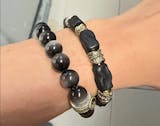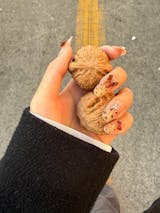Bodhi Seed Bracelet Guide: How to Wear, Play, and Care for Your Spiritual Beads
This page contains:
- What Is Bodhi Root?
- Why Bodhi Bracelets Should Avoid Water
- How to Properly Care for Bodhi Bracelets
- How Bodhi Bracelets Change Over Time
- How to Play with Bodhi Bracelets: Postures and Techniques
What Is Bodhi Root?
Bodhi root is not literally a "root" of the Bodhi tree. It is actually the seed of Corypha umbraculifera L., a species of palm whose broad leaves were traditionally used for transcribing sacred texts.
Many people confuse Bodhi root with true Bodhi seeds. In fact, what we use in prayer beads and bracelets is the inner kernel of the seed. The outer shell is rough, and once opened, reveals a soft white core with tiny cavities—details that help explain its unique handling and care needs.

Why Bodhi Bracelets Should Avoid Water
1. Low Density and High Absorption
Compared to dense hardwoods, Bodhi root has a lower density. While this makes it pleasantly lightweight, it also makes the material more sensitive to humidity. It easily absorbs moisture, leading to swelling, cracks, or deformation.
2. Hollow Interior Traps Moisture
The internal structure of Bodhi root includes a small hollow chamber. When exposed to water, moisture can collect in this cavity and gradually cause internal erosion, mildew, or decay—often invisible until permanent damage has occurred.

How to Properly Care for Bodhi Bracelets
Tip 1: Start with Clean Hands
Always wash your hands before touching Bodhi root. Its surface absorbs oils and dirt quickly, which can cause uneven coloration and dullness. Clean hands help ensure a smooth, even patina over time.
Tip 2: Avoid Oils and Lotions
Substances like hand cream and skincare oils easily adhere to the surface. These sticky residues not only stain the bead but also interfere with its natural polish. Handle only with dry, bare hands to preserve its purity.
Tip 3: Clean Gently and Regularly
As time passes, sweat and dust will accumulate. Use a soft, dry cloth to gently wipe the beads clean. Avoid chemical cleaners—they can damage the natural texture and color of Bodhi root.
Tip 4: Let It Age Naturally
The true beauty of Bodhi root emerges through daily use. Allow it to come into contact with your skin naturally. Over time, it will develop a warm patina that reflects age, care, and personal connection.

How Bodhi Bracelets Change Over Time
1. Cleaning & Base Preparation (1–2 weeks)
Use a nano brush to carefully clean the surface and drill holes of the Bodhi root beads, removing any remaining dust and residue from the manufacturing process. Then, wear gloves and gently rub the beads for 1–2 hours daily. The goal during this stage is to smooth the surface and begin forming an initial glaze-like layer (pre-patina).
2. Hand Conditioning & Patina Formation (Several months)
Once the beads start to show a slight sheen, you can begin bare-hand conditioning. Make sure your hands are clean and dry. Rub the beads evenly in your palm, allowing natural oils from your skin to absorb into the surface. Occasionally use a nano brush to remove dirt buildup. Over time, a thin layer of patina will gradually form, giving the beads a soft, lustrous appearance.
3. Resting & Oxidation (Intermittent)
After every 3–5 days of play, place the beads in a sealed bag for 2–3 days. This resting period allows the developing patina to oxidize and harden, which helps deepen the color and make it more even. By alternating between playing and resting, the Bodhi root beads will slowly darken and take on a more translucent, radiant texture.

How to Play with Bodhi Bracelets: Postures and Techniques
1. Coiling Around the Finger
Place the Bodhi bracelet on your hand. Rest your index finger on top of the bracelet, and thread your thumb through from above to form a figure-eight shape. Then press your index finger down at the center, while your thumb comes out through the loop and presses forward, creating a double loop. Gently push inward with your index finger, and at the same time, rotate your thumb counterclockwise with a light motion. Let your thumb follow along the inner circle of the bracelet, moving smoothly and closely against it.
2. Single Finger Rolling
When you're in a calm state of mind, gently rotating the beads one by one can be very beneficial for Bodhi bead maintenance. First, it ensures even conditioning, allowing each bead to receive equal attention. Second, the gentle motion helps protect the surface of the beads from damage.
3. Figure-eight Looping
Hold the Bodhi bracelet between your thumb and middle finger, and twist it into a figure-eight shape. Move your thumb outward to touch the knuckle of your middle finger. Then bend your middle finger to touch the base of your thumb. With both fingers pressed together, rotate them in a full circle. When you release, the bracelet naturally returns to a figure-eight shape. Repeat this motion in a smooth, continuous cycle.

Final Thoughts
Taking care of a Bodhi root bracelet isn’t complicated—it’s just about being patient and gentle. The more time you spend with it, the more it reflects your touch, your mood, even your daily routine. It doesn’t need to be perfect. Let it age slowly, let the color deepen, and enjoy the quiet process. In the end, it’s not just a bracelet—it’s something that grows with you.
FAQS
1. Why Shouldn't Bodhi Root Be Exposed to the Sun?
Sunlight dries out Bodhi root, causing it to crack. Water exposure can also lead to cracking due to expansion and shrinkage.
2. Can I Use a Scratch Board for Polishing?
Avoid using hard scratch boards. Vigorous rubbing can pit and damage the bead surface.
3. Do I Need to Wear Gloves While Handling the Beads?
Yes, especially if you sweat easily. Gloves protect the beads from hand oils and sweat, preventing discoloration.
Related Articles:
Step-by-Step: How to "Play" Bodhi Bracelet for Beautiful Results
The Ultimate Guide to Playing with Bodhi Bracelets: Stages of Transformation

























































